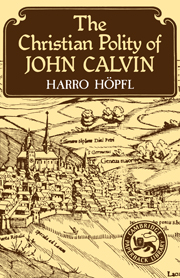Book contents
- Frontmatter
- Contents
- Preface
- Note on sources, orthography, notes and translations
- Introduction
- 1 The training of a lawgiver
- 2 The Institution: the first version
- 3 The first public ministry
- 4 Reconstruction
- 5 The Institution of 1543
- 6 Geneva and Calvin, 1541–64
- 7 The civil order of a Christian commonwealth
- 8 Political morality in the thought of Calvin
- 9 The laws and mores of a Christian commonwealth
- 10 Unfinished business: a speculative summary and postscript
- Appendix I Calvin's conversion
- Appendix II Predestination
- Notes
- Bibliography
- Index
- Cambridge Studies in the History and Theory of Politics
5 - The Institution of 1543
Published online by Cambridge University Press: 24 October 2009
- Frontmatter
- Contents
- Preface
- Note on sources, orthography, notes and translations
- Introduction
- 1 The training of a lawgiver
- 2 The Institution: the first version
- 3 The first public ministry
- 4 Reconstruction
- 5 The Institution of 1543
- 6 Geneva and Calvin, 1541–64
- 7 The civil order of a Christian commonwealth
- 8 Political morality in the thought of Calvin
- 9 The laws and mores of a Christian commonwealth
- 10 Unfinished business: a speculative summary and postscript
- Appendix I Calvin's conversion
- Appendix II Predestination
- Notes
- Bibliography
- Index
- Cambridge Studies in the History and Theory of Politics
Summary
The new edition of the Institution was now a large volume of twenty-one chapters; some of the chapters, not as yet divided into sections, had become very unwieldy. Wendel has said of this edition that ‘the alterations and additions [made in it] are of much less importance than those of the edition of 1539’. Certainly many of the changes and additions were simply amplificatory, or designed to ward off past or potential criticism; the host of quotations from Augustine was in the main of this sort. Others again simply used up material which Calvin presumably prepared for the various colloquia he attended. But the most amplified, changed and reworked section was that on ecclesiology, concentrated almost entirely into the exposition of the Creed's Credo unam sanctam catholicam ecclesiam, which now formed one chapter of enormous length. Here, as well as much material reproduced verbatim from previous editions, there were substantial and important novelties, and given that Calvin regarded ecclesiology as part of theology, it will hardly do to leave the matter at the comment that the new edition now ‘contained a somewhat detailed exposition of Calvin's ideas about ecclesiastical organization’. What it contained was the image of a godly church, defined not merely by exclusion (as non-papist) but positively, and with a decisiveness and clarity of outline without precedent elsewhere.
In this respect, the general tendency of the discussion to consolidate and make doctrinal the conclusions reached in public and private between 1538 and 1541 is indeed impressive.
- Type
- Chapter
- Information
- The Christian Polity of John Calvin , pp. 103 - 127Publisher: Cambridge University PressPrint publication year: 1982

